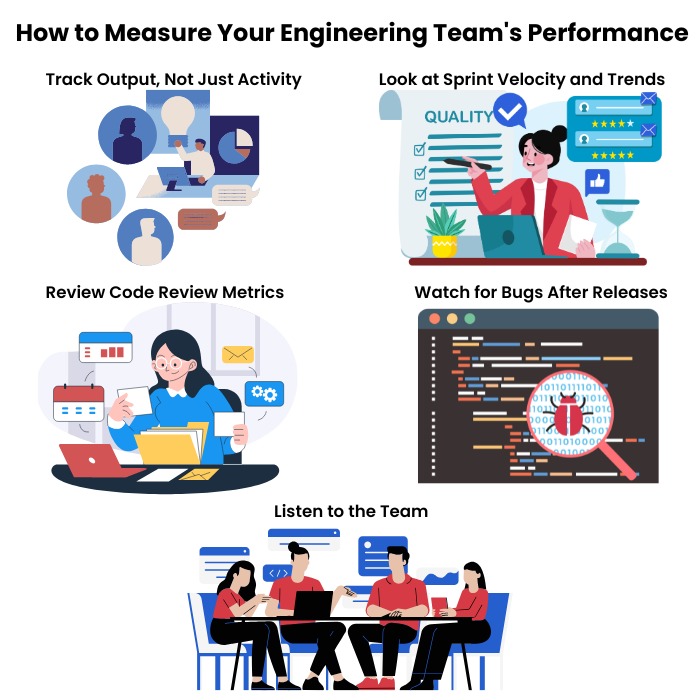Engineering team building isn’t about ping-pong tables or motivational posters—it’s about how people work together under pressure, ship code, and solve real problems. A strong team gets more done with less drama. A weak one slows everything down.
Great teams aren’t built by accident. They’re shaped by how you hire, onboard, lead, and communicate. What is the way you run standups, give feedback, and handle setbacks? That’s team building in action.
This guide explains how to build an engineering team that works with faster releases, better morale, and fewer blockers. So read on—this is where high-performing teams begin.
What Makes an Engineering Team Successful?
A successful engineering team gets real work done—on time, with quality, and without burning out. But it’s not just about smart people writing good code. It’s about how they work together, solve problems, and keep moving forward even when things break.
What Success Really Means
Success means more than shipping features. It’s delivering value consistently, improving with each sprint, and building trust across the team. That trust shows up in how feedback is shared, how decisions are made, and how people handle mistakes.
Strong teams don’t wait for permission. They’re clear on what matters, they take ownership, and they hold each other accountable. They ask good questions, write better code, and raise issues before they become blockers.
What Winning Teams Have in Common
- Clear Goals – Everyone knows what they’re working on and why it matters. No guessing, no confusion.
- Defined Roles – Engineers know where they fit, who to ask, and what’s expected of them.
- Trust and Respect – People feel safe speaking up and pushing back without fear.
- Good Communication – Problems get surfaced early, and no one’s left out of the loop.
- Focus on Growth – Learning is baked into the work, not treated as an extra.
Step-by-Step Guide to Building an Engineering Team

You can’t build a great product without a great team, and great teams don’t come together by accident. Here’s a practical, step-by-step playbook to help you do it right from day one.
Step 1: Laying the Foundation—Hiring and Team Composition
Before anything else, get the right people in the room. Don’t just hire great engineers—hire the right ones for your goals.
- Start with a plan. What does your product need? Back-end specialists? Mobile developers? Data engineers? Let your roadmap shape your hiring.
- Balance is key. Mix senior engineers who can lead with juniors who can grow. If it is too top-heavy or too green, progress will slow.
- Hire for how they think, not just what they know. Prioritize collaboration, ownership, and curiosity. Technical skills can grow, but mindsets take longer.
- Build for diversity from day one. People from different backgrounds bring better ideas. Diversity also makes your culture stronger, more creative, and more human.
Let me explain—without a solid hiring strategy, there will be gaps, overlaps, and mismatched expectations.
Step 2: Onboarding and Integrating New Engineers
Your new hire’s first 30 days shape everything—from confidence to retention.
- Have a structured onboarding plan. Clear documentation, tool access, coding guidelines, and a go-to person for questions.
- Give early wins. Small tasks with real value build momentum and help them feel useful fast.
- Use mentorship, not micromanagement. Pair them with a teammate who shows them the ropes and shares context.
- Make them feel part of the team. Invite them to retros, chats, even informal calls—don’t isolate them.
Now here comes the good part—engineers who feel welcomed and informed contribute faster and stick around longer.
Step 3: Engineering Team Dynamics and Communication
Bad communication breaks good teams. Get this right, and everything else works smoother.
- Create safe channels for honest conversations. Engineers should feel okay admitting mistakes, asking for help, or raising issues.
- Set expectations around feedback. Code reviews should teach, not criticise. Feedback should be regular, not reactive.
- Use tools wisely. Slack, GitHub, and Jira—they help when they’re organized, not when they add noise.
- Keep standups short, async updates clear, and retros focused. Avoid meetings that drain time without adding value.
So read on—because building trust through good communication is the glue that holds great teams together.
Step 4: Leadership and Management in Engineering Teams
Even smart teams need direction. Strong leadership doesn’t mean control—it means clarity.
- Separate technical leadership from people leadership. Tech leads focus on architecture, while engineering managers focus on people and delivery.
- Set goals, not tasks. Let engineers decide how to get there. Autonomy drives ownership.
- Run regular 1:1s. Ask more than “how’s the project?” Talk about growth, blockers, and what’s working or not.
- Coach, don’t command. Ask questions, unblock problems, and support, not just assign.
Step 5: Building Team Culture and Engineering Identity
Culture isn’t perks. It’s how your team acts when no one’s watching.
- Write down your values. Keep it short and real. Things like “ship often,” “own your code,” or “ask why” mean more than corporate buzzwords.
- Build traditions. Weekly demos, bug bashes, or Friday wins are small things that build identity and pride.
- Celebrate learning. Praise people for sharing mistakes or improving processes, not just for hero work.
- Give the team a voice. Let engineers shape their work and suggest changes. Buy-in builds belief.
Great culture doesn’t happen by accident—it grows from consistent habits and shared wins.
Step 6: Continuous Development and Team Growth
If your team isn’t growing, it’s stalling. Make learning part of the job, not something squeezed in after hours.
- Invest in development. Budget for courses, books, and conferences. Start internal tech talks or reading clubs.
- Make growth paths clear. Show what progress looks like, whether someone wants to lead or stay deep in the code.
- Encourage mentorship. Let seniors lift others. It sharpens leadership skills and builds team strength.
- Review performance regularly. Use check-ins to support, not surprise. Feedback should feel like guidance, not judgment.
Engineers stay where they see a future. Help them level up, and they’ll level up your team.
Step 7: Team Building Activities and Rituals That Work
Work isn’t the only place teams grow. Bonding builds trust, and trust builds better products.
- Do lightweight check-ins. 10-minute coffee chats or virtual “get-to-know-you” games break the ice.
- Host regular events. Monthly hackathons, shared lunches, or game nights—keep it casual, not forced.
- Adapt for remote teams. Async intros, virtual coworking sessions, or shared playlists go a long way.
- Let the team lead it. Ask what they enjoy—don’t guess.
The best rituals don’t feel like “team-building”—they feel like friends working well together.
Common Pitfalls to Avoid in Engineering Team Building
Even with the best intentions, some mistakes quietly stall progress. Avoid these five traps:
1. Overengineering the Process
Trying to make everything perfect—roles, workflows, documentation—can slow down momentum. Build the team, then improve as you go. Progress beats perfection.
2. Ignoring Burnout Signals
Pushing too hard for too long backfires. Missed deadlines, quiet meetings, or short tempers are signs that something’s off. Check in, adjust pace, and protect your team’s energy.
3. Promoting Without Preparation
Promoting top engineers into leadership without training sets them up to struggle. Leading people is a different skill—coach them before handing them a team.
4. Misaligned Incentives
If one person is rewarded for speed and another for quality, you’ll get chaos. Align goals across roles so everyone rows in the same direction.
5. Skipping Feedback Loops
Teams can’t improve what they don’t talk about. Without regular feedback—1:1s, retros, or check-ins—issues go unnoticed until they become problems.
How to Measure If Your Engineering Team Is Actually Working Well

You can’t fix what you don’t track. A team might look busy, but that doesn’t mean it’s healthy or productive. Here’s how to check what’s going on:
1. Track Output, Not Just Activity
Watch for consistent delivery, not just long hours. Are features shipping? Are bugs closing? Burnout often hides behind a wall of “we’re slammed.”
2. Review Code Review Metrics
Are reviews thoughtful and timely? Too fast means rubber-stamping. Too slow stalls progress. Good reviews lead to better code and shared learning.
3. Look at Sprint Velocity and Trends
Velocity isn’t about story points—it’s about stability. If your team’s output bounces wildly, there’s likely a workflow or planning issue to address.
4. Watch for Bugs After Releases
Frequent regressions signal quality issues. Track post-release bugs to spot testing or handoff problems early.
5. Listen to the Team
Surveys, 1:1s, and retro feedback give you the real picture. Are people motivated, or just hanging on? Are they growing or stuck?
Conclusion
Building a high-performing engineering team isn’t a one-time task—it’s an ongoing commitment to hiring thoughtfully, leading clearly, and creating space for growth. The best teams aren’t the ones with the most talent on paper—they’re the ones that work well together, ship consistently, and improve every sprint.
If you focus on clarity, trust, and constant feedback, the results will follow. Great teams build great products—and it all starts with how you make the team.
So start simple. Stay consistent. And keep building.




